Picture this: the sizzle of a perfectly cooked steak or the mouthwatering aroma of roasted pork. But before you can indulge in these savory delights, you need to prepare your meat. And an essential part of that process is using a cutting board to slice and dice your protein. But did you know that using the same cutting board for different types of meat could be hazardous to your health?
Many home cooks think they can use one cutting board for all meats without any issues. However, cross-contamination is a genuine concern when it comes to preparing various types of meat on the same surface. This means that bacteria from one type of meat can transfer onto another, leading to foodborne illnesses like salmonella and E. coli.
So, can you use the same cutting board for different meats? It’s not a straightforward answer as there are several factors to consider. In this blog post, we’ll delve into the different kinds of cutting boards available, discuss the risks associated with cross-contamination, and provide best practices for using cutting boards to keep your kitchen safe and your meals delicious. So grab your knives and get ready to learn everything you need to know about using a cutting board for different meats.
Contents
What is Cross-Contamination?
Essentially, cross-contamination happens when harmful bacteria or pathogens are transferred from one food product to another. This can occur when different types of food come into contact with each other, such as when using the same cutting board for multiple meats. It’s a serious concern in food safety because it can lead to foodborne illnesses.
Bacteria can linger on cutting boards, knives, and other kitchen surfaces for hours or even days. When raw meat comes into contact with these surfaces, the bacteria can easily spread to other foods that touch the same surface. This is why it’s crucial to use separate cutting boards and utensils for different types of food, particularly raw meat.
Foodborne illnesses can range from mild to severe and can present symptoms like nausea, vomiting, diarrhea, and fever. In some cases, foodborne illnesses can even be life-threatening, especially for young children, pregnant women, and the elderly.
There are simple steps you can take to prevent cross-contamination in your kitchen. Here are a few:
- Wash your hands and kitchen surfaces before and after handling food.
- Use separate cutting boards for different types of food. Have one designated for raw meat and another for fruits and vegetables.
- Use separate utensils for different types of food.
- Avoid reusing plates or utensils that have come into contact with raw meat without washing them first.
- Clean and sanitize your cutting board between uses by washing it with hot, soapy water followed by disinfecting it with water and bleach.
Types of Bacteria Found in Different Meats
The kitchen can be a dangerous place, especially when it comes to handling raw meat. Cross-contamination can occur if bacteria from one type of meat is transferred to another type of meat, potentially causing foodborne illness.
Different types of meat can carry different types of bacteria, so it’s important to be aware of the potential risks. Here are some tips on how to prevent cross-contamination and keep your food safe to eat.
Use Separate Cutting Boards for Different Types of Meats
Using the same cutting board for different types of meats increases the risk of cross-contamination and the spread of harmful bacteria. Chicken, for example, is known to harbor Salmonella and Campylobacter bacteria, both of which can cause serious illness in humans. Beef can contain E. coli and Listeria, while pork can harbor Yersinia and Salmonella. Fish and shellfish can also contain harmful bacteria such as Vibrio and Clostridium.
To minimize the risk of cross-contamination, it’s recommended to use separate cutting boards for different types of meats. This can help prevent the spread of harmful bacteria and keep your food safe to eat.
Clean and Sanitize Your Cutting Board Between Uses
If using one cutting board for multiple meats is necessary, it’s important to thoroughly clean and sanitize the board between uses to prevent any potential cross-contamination. This involves washing it with hot, soapy water and then disinfecting it with a solution of water and bleach. This step is crucial in preventing the spread of harmful bacteria.
Be Aware of the Bacteria That Can be Found in Different Meats
Different meats can carry different types of bacteria, and it’s important to be aware of these risks when handling raw meat in the kitchen. For example, beef and pork can contain E. coli and Salmonella, while chicken and turkey can carry Campylobacter and Salmonella.
Additionally, ground meats have a higher risk of bacterial contamination due to the grinding process. Seafood can also carry its own set of bacteria, such as Vibrio and Listeria.
It’s important to note that not all bacteria are harmful, but some can cause serious illness if ingested. Symptoms of foodborne illness can range from mild stomach discomfort to severe illness and even death in some cases.
Use Separate Utensils for Different Types of Meats
In addition to using separate cutting boards, it’s also recommended to use separate utensils for different types of meats. This helps prevent cross-contamination and reduces the risk of foodborne illness. Make sure to use different knives, tongs, and other utensils for each type of meat you handle.
The Risk of Using the Same Cutting Board for Different Types of Meat
Using the same cutting board for different types of meat may seem like a time-saving option, but it can lead to severe health consequences. Cross-contamination is a real risk that can occur when harmful bacteria from one type of food comes into contact with another type of food. When it comes to meat, each type carries its own unique set of bacteria that can cause foodborne illnesses if not handled properly. Here are five reasons why you should avoid using the same cutting board for different types of meat:
Different Types of Meat Carry Different Bacteria
Raw chicken and turkey often carry salmonella and campylobacter bacteria, while beef and pork can harbor E. coli bacteria. Using the same cutting board for all types of meat can result in harmful bacteria mixing together, increasing the risk of foodborne illness.
Cross-Contamination is a Real Risk
If you use a cutting board to prepare raw chicken or other meats and then use the same cutting board to prepare vegetables without cleaning it correctly, bacteria from the raw meat can transfer onto the vegetables and cause illness if eaten raw or undercooked.
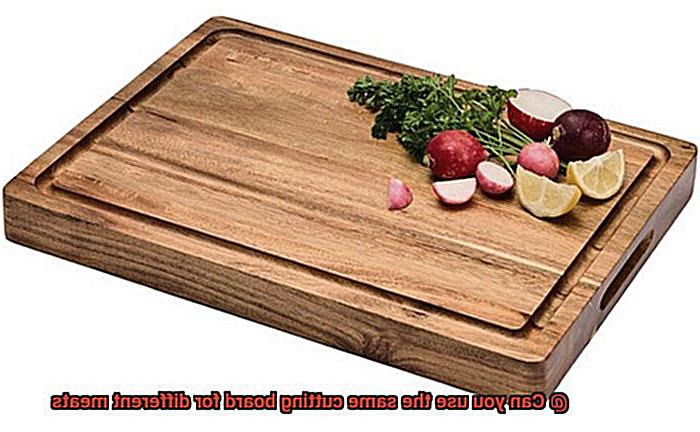
The Consequences Can Be Severe
Foodborne illnesses can have serious consequences, especially for vulnerable populations such as young children, pregnant women, and elderly adults. Even a small amount of harmful bacteria can cause serious illness or even death in these cases.
It’s Easy to Prevent
To reduce the risk of cross-contamination, it’s crucial to use separate cutting boards for different types of meat. This will help prevent harmful bacteria from spreading and keep your food safe to eat. Additionally, it’s vital to wash your cutting boards thoroughly with hot soapy water after each use to remove any remaining bacteria.
It’s Better to Be Safe Than Sorry
While it may be tempting to use the same cutting board for different types of meat, it’s not worth the risk of cross-contamination and potential foodborne illness. It is always best to use separate cutting boards for different types of meat and clean them thoroughly after each use.
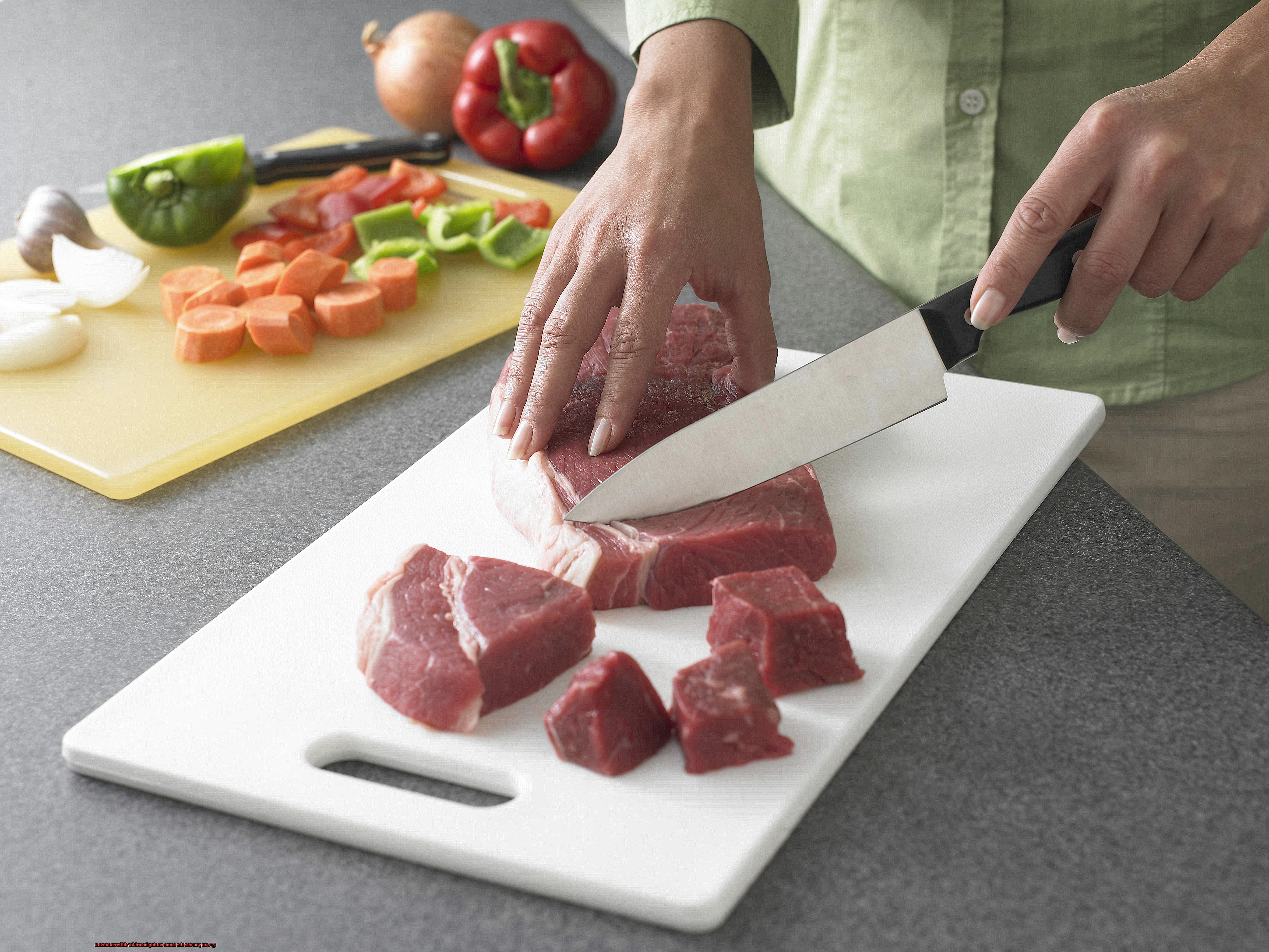
Separate Cutting Boards for Different Types of Meat
When it comes to ensuring food safety in the kitchen, using separate cutting boards for different types of meat is a must. Here’s why:
Preventing Cross-Contamination
Cross-contamination is the transfer of harmful bacteria from one food item to another. When you use the same cutting board for different types of meat, you run the risk of spreading bacteria from one piece of meat to another. This can lead to serious foodborne illnesses like salmonella and E. coli.
Different Types of Meat Carry Different Bacteria
Different types of meat carry different types of bacteria. For example, chicken is more likely to carry salmonella, while beef is more likely to carry E. coli. Using the same cutting board for both types of meat can increase the risk of cross-contamination and make you sick.
The FDA Recommends a Color-Coded System
The FDA recommends using a color-coded system for cutting boards. This means using a different colored board for each type of food: red for raw meat, yellow for poultry, green for vegetables and fruits, and blue for seafood. This helps prevent cross-contamination and ensures that each type of food is prepared on a separate surface.
Proper Cleaning and Sanitizing is Crucial
If you don’t have separate cutting boards, you can minimize the risk of cross-contamination by thoroughly cleaning and sanitizing your board after each use. This means washing it with hot soapy water and then sanitizing it with a solution of water and bleach.
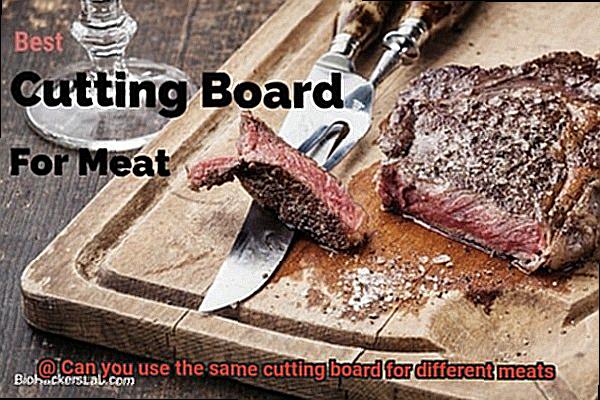
Disposable Cutting Boards are an Option
Disposable cutting boards made of paper or plastic are another option if you don’t have separate cutting boards or can’t afford to buy multiple ones. These can be thrown away after each use, reducing the risk of cross-contamination.
Cleaning and Sanitizing Your Cutting Board Between Uses
To ensure food safety, it’s crucial to clean and sanitize your cutting board properly between uses. Cross-contamination is a real risk when different types of meats are prepared on the same board, which can lead to foodborne illnesses.
Here are some tips to make sure your cutting board is always safe for use:
- Scrub off any food debris from the board using a bench scraper or the edge of a knife. This will make the cleaning process easier.
- Use hot, soapy water to thoroughly wash both sides of the board, making sure to get into all the nooks and crannies.
- Rinse the board with hot water and then dry it with a clean towel. Moisture can lead to bacterial growth, so make sure it’s completely dry before using it again.
- Sanitizing your cutting board is just as important as cleaning it. You can use a solution of one tablespoon of unscented, liquid chlorine bleach per gallon of water to sanitize your cutting board. Apply the solution to the entire surface of the board and let it sit for a few minutes before rinsing it off with hot water and drying it thoroughly.
If you prefer not to use bleach, there are commercial sanitizers specifically designed for cutting boards that are easy to use and effective.
If you have a wooden cutting board, remember that it requires special care. Avoid soaking it in water or putting it in the dishwasher as this can cause warping and splitting. Instead, clean it with hot, soapy water and sanitize with a solution of one teaspoon of unscented bleach per quart of water.
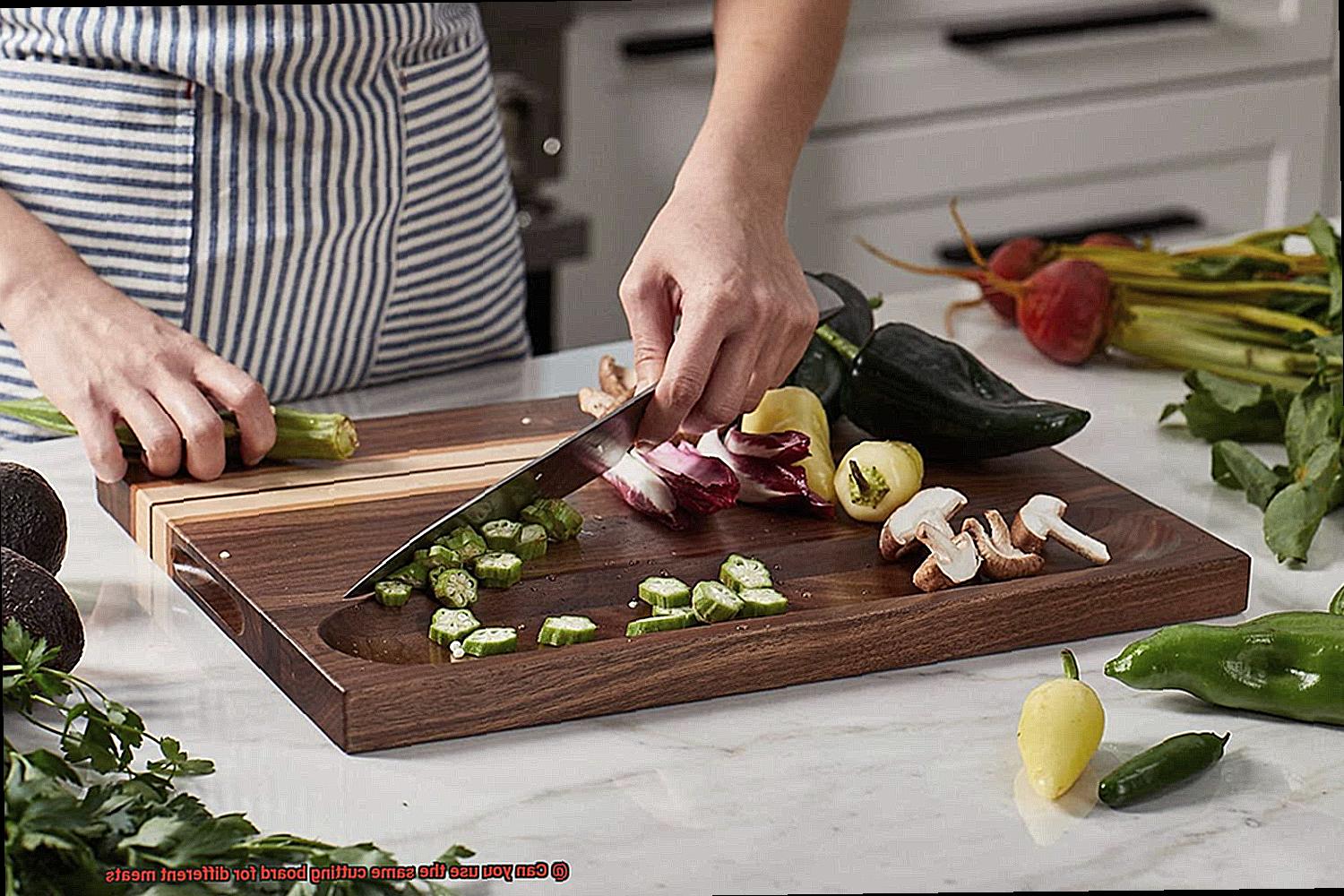
The Final Decision: To Use the Same Cutting Board or Not?
Cooking is an art, and as with any art form, attention to detail is crucial. One such detail that often goes unnoticed is the decision of whether or not to use the same cutting board for different meats. This seemingly insignificant choice can have a major impact on both your health and the flavor of your dishes.
The foremost factor to consider when making this decision is the risk of cross-contamination. Bacteria can easily spread from one type of meat to another, potentially causing foodborne illnesses. While washing your cutting board thoroughly between uses may seem like a solution, it’s essential to note that not all bacteria can be removed through washing alone. Wooden cutting boards, in particular, can harbor bacteria in their grooves and pores, making it challenging to ensure complete sanitation.
Another important consideration is the effect on flavor. Using the same cutting board for different meats can result in flavors mixing together, which may not be desirable for certain dishes. For example, if you’re preparing a delicate fish or chicken dish, you wouldn’t want the strong taste of beef or pork overpowering its subtle flavors.
So what’s the verdict? It ultimately depends on your personal preference and level of risk tolerance. Those who are extra cautious about food safety may opt for separate cutting boards for each type of meat. This ensures minimal risk of cross-contamination and provides peace of mind when cooking.
However, if you prefer to use a single cutting board, ensure that it’s thoroughly washed and sanitized between uses. Scrub off any debris and wash with hot soapy water before sanitizing with bleach or a commercial sanitizer, especially if it’s wooden. Remember to handle meat safely by washing your hands and any utensils or surfaces that come into contact with raw meat, cooking meat to the appropriate temperature, and storing it at the proper temperature.
Benefits of Using Separate Cutting Boards for Different Types of Meat
Using separate cutting boards for different types of meat is an essential practice for maintaining food safety in your kitchen. Cross-contamination from one type of meat to another can lead to harmful bacteria and other microorganisms that can cause foodborne illnesses. Here are five benefits of using separate cutting boards for different types of meat:
Reducing the Risk of Cross-Contamination
One of the primary benefits of using separate cutting boards is reducing the risk of transferring harmful bacteria from one type of meat to another. For example, cutting raw chicken on a cutting board and then using the same board to cut vegetables can easily transfer bacteria from the chicken to the vegetables, increasing the risk of food poisoning.
Improving Kitchen Hygiene
Using separate cutting boards can also help to improve the overall hygiene and cleanliness of your kitchen. By avoiding mixing different types of meats, you can keep your kitchen clean and organized. Additionally, it helps prevent any unwanted odors or flavors from being transferred between different types of meats.
Extending Knife Lifespan
Cutting through bones and tough meat can quickly dull your knives. By using separate cutting boards, you can avoid damaging your knives and prolong their lifespan. This not only saves you money but also ensures that your knives are always sharp and ready for use.
Preventing Foodborne Illnesses
Using separate cutting boards is a simple yet effective way to ensure that your food is safe, hygienic, and healthy. It’s a small step that can have a big impact on your overall health and wellbeing. By taking this precaution, you can reduce the risk of foodborne illnesses and enjoy delicious meals without any worries.
Easier Clean-Up
Lastly, using separate cutting boards makes clean-up much easier as you do not have to worry about sanitizing one board in between uses. You can simply use one board for meat and another for fruits and vegetables, making your kitchen routine more efficient.
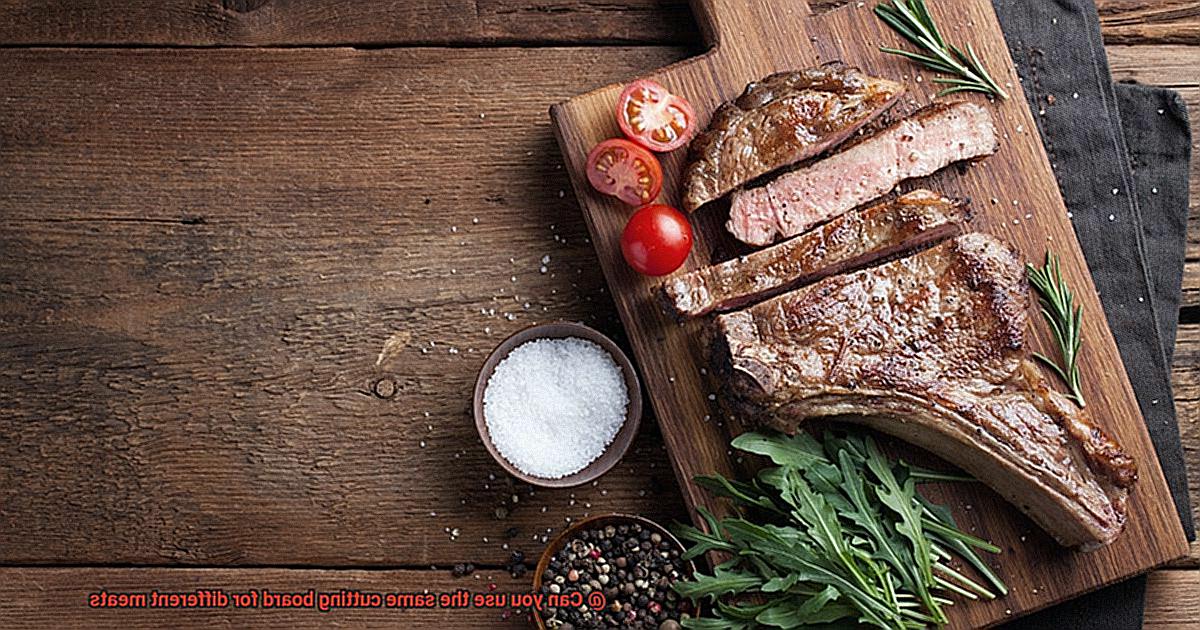
Disadvantages of Using Separate Cutting Boards for Different Types of Meat
You might find it convenient, but there are several disadvantages to doing so. In this article, we’ll explore five sub-sections of the disadvantages of not using separate cutting boards for different types of meat.
Increased Risk of Cross-Contamination:
Using the same cutting board for different types of meat significantly increases the risk of cross-contamination. Bacteria from one type of meat can easily transfer onto another type of meat, increasing the likelihood of foodborne illnesses. For instance, if you use the same cutting board for raw chicken and then use it to cut vegetables without properly cleaning it first, you run the risk of spreading harmful bacteria onto your vegetables.
Affects Taste and Quality:
Cross-contamination can cause the flavors of different meats to mix, resulting in an unpleasant taste. For example, if you use a board for strong-flavored meats like beef or lamb and then use it to cut delicate fish or poultry, the flavors can mix and alter the taste of the dish. Additionally, using the same cutting board for different types of meat can cause the board to become stained and retain odors, which can also affect the taste and quality of your food.
Hygiene Issues:
Not using separate cutting boards can also be a hygiene issue. If you do not properly clean your cutting board between uses, it can become a breeding ground for bacteria. This can not only affect the taste and quality of your food but also pose a health risk to you and your family. Certain meats require higher cooking temperatures to kill bacteria and viruses. If these meats have been cut on the same board as other meats, it can be difficult to ensure that all surfaces have been properly cleaned and sanitized.
Difficulty in Cleaning:
Using the same cutting board for everything can also make it more difficult to properly sanitize and clean. Certain meats need higher cooking temperatures to kill bacteria and viruses. If these meats have been cut on the same board as other meats, it can be difficult to ensure that all surfaces have been properly cleaned and sanitized.
Unnecessary Health Risks:
Using the same cutting board for different types of meat is an unnecessary health risk that can be easily avoided. By using separate cutting boards for different types of meat, you can reduce the risk of cross-contamination, improve the taste and quality of your food, and ensure proper hygiene in your kitchen.
4zCpUtpVmA0″ >
Conclusion
In conclusion, it is not recommended to use the same cutting board for different meats.
Cross-contamination can occur, leading to foodborne illnesses. It is important to have separate cutting boards for raw meats, cooked meats, vegetables, and fruits.
By doing so, you can ensure the safety and quality of your meals. Don’t let laziness or convenience compromise your health.
Take the extra step to keep your kitchen clean and organized.






